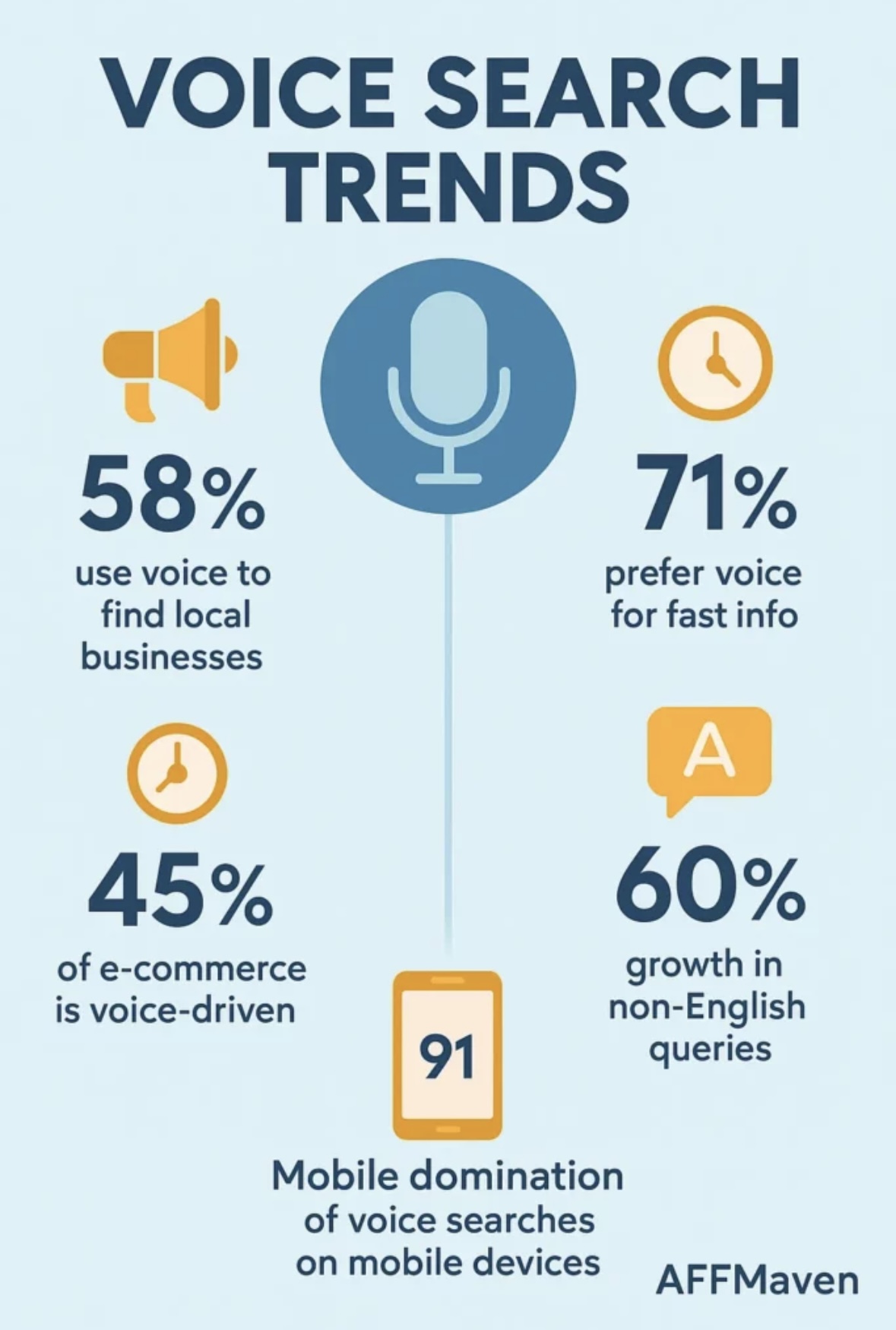Voice search is changing how people discover information. Instead of typing short keywords, users speak full questions into phones, smart speakers, and virtual assistants.
To stay visible, brands have to build content that aligns with spoken language, quick & simple answers, and user intent.
Voice SEO strategies focus on natural phrasing, structured information, and mobile-friendly experiences to help search engines choose your content when reading answers aloud. Below are the main things to know before reshaping your content approach for voice.
Quick Takeaways
- Conversational language and question-based keywords increase visibility in spoken search.
- FAQ and snippet-style formatting improve your chance of being selected as a voice answer.
- Structured data helps engines understand and rank your content more accurately.
- Faster mobile pages are prioritized for voice search responses.
- Ongoing content updates keep your site aligned with changing search behavior.
Understand Search Language Changes
Voice search queries tend to be longer and more conversational than typed ones. Instead of “running shoes reviews,” users say, “What are the best running shoes for long-distance training?”
To optimize your content for voice, include sentences and subheadings that mirror how people talk. Focus on natural questions and direct answers. Target long-tail phrases that begin with “how,” “why,” “what,” “when,” and “where.”
This approach helps your content appear in “featured snippets” or answer boxes that smart devices often use to respond.

Image source
Use Clear Structure and Snippet-Friendly Formatting
Voice assistants pull brief, well-structured answers. Pages with short paragraphs, simple headers, and direct summaries have higher chances of being selected. Add FAQ sections to key pages and answer each question in one or two sentences. Use bullet points to list steps, ingredients, or comparisons whenever possible.
- Start with common user questions as headers
- Follow each with a 40–50 word answer
- Use lists to present solutions quickly
- Place the most valuable information in the beginning
Implement Structured Data Markup
Structured data tells search engines what each part of your site means.
Use FAQPage, HowTo, and Article schema to highlight your answers and increase voice visibility. This adds context to your content and allows search engines to confidently read responses aloud from your pages.
Also, you want to include your business details like hours and address to support voice queries for “near me” and other local searches.
Optimize For Local And Mobile Voice Searches
Many voice searches involve immediate needs or local results, like “Where is the closest urgent care?” Here’s what you should do:
- Make sure your location pages contain accurate names, addresses, and phone numbers and that your Google Business Profile is up to date.
- Use local keywords naturally in your body text and headings.
- Confirm your website loads quickly on mobile devices using tools like PageSpeed Insights.
Page speed and mobile usability are major factors in whether voice assistants display your content as a response.
Aligning Voice SEO Strategies with Buyer Intent
Voice search isn’t only about matching how people speak—it’s also about understanding why they’re asking a question in the first place. Building content for voice search that aligns with buyer intent makes your efforts more effective because it connects spoken queries with the real goals behind them.
Understanding Intent in Voice Search
Most voice searches fall into a few categories: seeking quick facts, finding local businesses, or exploring options before making a purchase. For example, a user might ask:
- “What is a B2B channel partner?” (informational intent)
- “Which software has the best reviews for B2B marketing?” (research intent)
- “Where can I compare B2B channel partner platforms?” (transactional intent)
Recognizing these intent types helps you organize your content in a way that meets users where they are in their search journey.
Creating Content That Meets Intent
When developing content for voice search, map each piece to a specific intent:
- Use glossary pages and blog posts to answer broad, informational questions.
- Build comparison guides or FAQs to support research-based queries.
- Optimize product or service pages with structured data for transactional searches.
By aligning your content with intent, you increase the chance of being chosen as the spoken answer—and also guide users naturally toward deeper engagement.
Why Intent Alignment Strengthens Voice SEO
Search engines want to deliver answers that satisfy user needs quickly. If your content directly addresses intent, it’s more likely to be surfaced in results and read aloud. Pairing intent-focused content with technical voice SEO strategies creates a stronger foundation for long-term visibility.
Continuously Update Voice-Ready Content
Search trends shift over time. Review which voice-style queries your site ranks for using tools like Google Search Console.
Identify underperforming pages and update them with new question-based headings or answers. Refresh FAQs regularly to match current language trends, and update schema when you post new content. This makes sure your strategy evolves with user expectations and changing device behaviors.

Image source
Tools To Support Voice SEO Strategies
Voice search optimization becomes easier when using tools that highlight how users actually speak.
There are keyword platforms that surface long-tail, question-based queries commonly spoken into devices. These tools help content teams identify natural language questions that your target audience is already asking.
Google Search Console can also reveal which of your pages are earning impressions for voice-style queries, allowing you to refine headings and answers based on real behavior. Monitoring page performance by device type (especially mobile) gives insight into which content is most likely to be selected by voice assistants.
Measure Success And Maintain Momentum
Voice SEO is not a one-time launch but an ongoing process. Track your results using a mix of technical and business metrics.
On the technical side, monitor rich results earned, featured snippet wins, mobile page speed, and impression counts for question-based keywords.
On the business side, assess user engagement, organic traffic from mobile devices, and conversion rates linked to voice-optimized pages.
Regular reviews help identify which content should be refreshed with updated language, faster answers, or added schema. Stay ahead of evolving trends by monitoring how users phrase new questions over time. Continuous refinement will help keep your voice search performance from fading as user habits change.
Keep Content Conversation Ready
Voice search optimization doesn’t replace traditional SEO—it expands it. By adapting your content for spoken language, fast answers, mobile usage, and structured markup, your brand can stay competitive as user preferences shift. Start evolving your content now to connect with audiences who choose to search using their voice instead of their hands.
If you’re ready to get more traffic to your site with quality content that’s consistently published, check out our Content Builder Service and set up a consultation. Get started today and generate more traffic and leads for your business.
Read More
By: Lauren Basiura
Title: Integrating Voice Search Optimization into Your Content Strategy
Sourced From: marketinginsidergroup.com/search-marketing/integrating-voice-search-optimization-into-your-content-strategy/
Published Date: Tue, 14 Oct 2025 10:00:47 +0000
.png)





